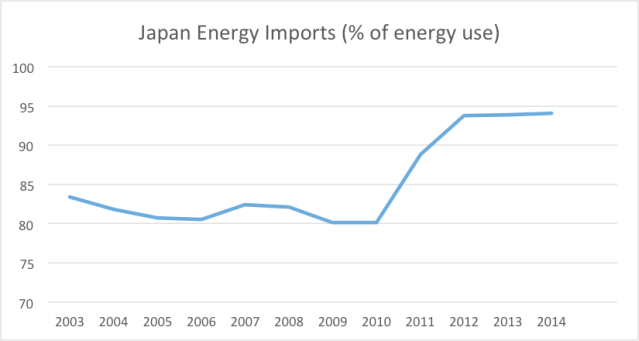by Aaron Wood
Following the Fukushima disaster in 2011, Japan has been seeking to convert its traditionally atomic electricity generation capacities to fossil fuels in the interest of safety from natural disasters, deciding to maintain a baseload of only 20 to 22% in the energy mix from nuclear power plants until 2030. Lacking the resources to generate necessary power at home, Japan’s net energy imports as a percentage of total energy used increased from an already high level of 80% in 2010, to 94% in 2014. The sudden jump in reliance on gas for electricity generation is reflected in Japan consisting for over a third of global LNG demand in 2012.

Figure 1. Japan Energy Imports as a Percentage of Energy Use
Recently Japan has been exploring the opportunity to supply its growing reliance on hydrocarbons domestically via the offshore harvesting of gas hydrates, despite the glut in oil prices dampening the need to search for alternative fuel sources. Gas hydrates are a crystalline, ice-like form of water in which non-polar molecules are encased in hydrogen-bonded, frozen water molecules. Many such crystalline structures, nearly 1,100 bcm worth, have been found off the southeast coast of Japan. Over the course of the last three years, Japan has shown significant interest in developing gas hydrate resources, conducting test operations in 2013 by Japan Oil, Gas and Metals National Corp. (JOGMEC), until sand shifting on the ocean floor halted operations. Last summer JOGMEC returned to continue work on the site.
The prospect of unlocking another energy source in coastal waters has proven appealing to other players as well. A cooperative scientific expedition with scientists from the United States, India, and Japan has recently discovered large deposits of gas hydrates in the Indian Ocean. India, in an effort to shift away from coal, is searching for alternative energy sources and could supply its gas needs with domestic hydrate production, while American companies stand to expand their export capacities with the addition of yet another unconventional source of gas production.
While some are hailing gas hydrates as a fuel of the future, many are quick to note the environmental effects of not only the gas once it is burned, but the effects of the extraction itself. Gas hydrates contain a variety of different gases. Throughout the processing, burning, or dissolution of these hydrates it is quite possible for these gases to escape, some of which, such as CH4, are more effective greenhouse gases than even CO2. GNS Science, a New Zealand science consultancy firm, is quick to note that dissolving or “melting” gas hydrates could not only affect the atmosphere once gas is released, but also influences the stability of ocean floors. Premature or excessive dissolution of gas hydrates could result in shifts on the ocean floor, which in turn could influence waves patterns, coastal stability, erosion, and even weather patterns.
The IEA has voiced its concern for Japan’s increasingly carbonized energy mix. Not only will more emissions fly in the face of Japanese commitments to the COP21 agreement made in January, but the increased reliance and consumption of fossil fuels has led to unsustainably high prices on the Japanese domestic market, hitting the pocketbooks of Japanese consumers. The IEA has called for a return to nuclear energy in addition to scaling up Japan’s renewable energy commitments.

Figure 2. Nuclear Reactors in Japan
This puts the country’s leadership in a tricky position. Increased carbonization is undesirable to environmental activists and economists alike, while the Japanese public at large still remains opposed to returning to nuclear energy, as the memory of the Fukushima disaster and its fallout still remain persistent. Polls of the Japanese public have found that 53% of respondents favored a decrease in nuclear energy, while 20% preferred to abolish it altogether. Conversely, the Mizuho Information & Research Institute of Japan conducted a survey asking respondents whether they would favor nuclear energy use if it meant their energy costs were the same or less than they would otherwise be that month. 67% answered “yes” while 32% answered “no”.
Moving forward, Japanese leadership will have to balance the varying interests at home, as well as those of potential partners in developing the gas hydrate resources, as foreign countries and inevitably, foreign companies, get involved in the process. As of yet, research is still being conducted regarding the viability and environmental safety of gas hydrate production. At best, it could be a convenient new source of transitionary fuel, and at worst, another environmental catastrophe waiting to happen.
FEPC, 2016. Japan’s Energy Supply Situation and Basic Policy. FEPC. Accessed: 20 October, 2016.
IEA Statistics, 2014. Energy imports, net (% of energy use). The World Bank. Accessed: 19 October, 2016.
Chee Yew Cheang, 2016. Japan Progresses Methane Hydrate Project, Ignores Industry Downturn. Rigzone. 11 July, 2016.
Sonal Patel, 2016. Gas Hydrates: Fuel of the Future? Powermag. 5 January, 2009.
GNS Science, 2016. What are Gas Hydrates? GNS Science. Accessed 19 October, 2016.
IEA, 2016. IEA urges Japan to decarbonise its energy supply. IEA. 21 September, 2016.
World Nuclear Assocation, 2016. Nuclear Power in Japan. World Nuclear Association. Accessed 20 October, 2016.
